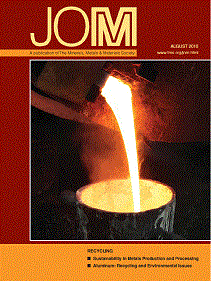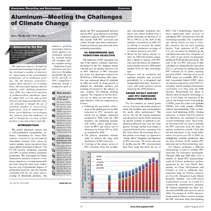 LATEST ISSUE |
||||
TMS QUICK LINKS: |
• TECHNICAL QUESTIONS • NEWS ROOM • ABOUT TMS • SITE MAP • CONTACT US |
JOM QUICK LINKS: |
• COVER GALLERY • CLASSIFIED ADS • SUBJECT INDEXES • AUTHORS KIT • ADVERTISE |
|
| Aluminum: Recycling and Environment | Vol. 62, No.8 pp. 33-36 |
Jerry Marks and Chris Bayliss
|
The aluminum industry, through the International Aluminium Institute (IAI), has developed a number of objectives for improvement in the environmental performance of its production facilities. The IAI measures performance against these objectives on an annual basis. The latest data indicates that the industry, while doubling production since 1990, has reduced its emissions of perfluorocarbon greenhouse gases by almost 80% over the same period. However, the largest potential for emission reduction is through the use of aluminum products in energy-saving applications, such as lightweight vehicles, green buildings, and packaging that protects food and medicines, as well as through the recycling of these products at the end of their useful life. The global aluminum industry has
a well-established sustainability initiative,
“Aluminium for Future Generations,”
overseen by the International
Aluminium Institute (IAI), whose directors
include senior executives from
major global aluminum producers. The
27 IAI member companies represent
over 80% of global primary aluminum
production. The Aluminium for Future
Generations initiative is built on 14 voluntary
objectives, covering sustainability
issues along the value chain, including
not only environmental impacts of
production processes, but also benefits
associated with the use, reuse, and recycling
of aluminum products. The incorindustry’s
performance toward these
quantitative objectives is measured annually
against a set of sustainable development
indicators. Annual results
are assessed through surveys of both
IAI members and non-members and
are available through the IAI website.1
To assure reliable and accurate reporting of greenhouse gas emissions the industry, working collaboratively with U.S. Environmental Protection Agency (EPA), the Intergovernmental Panel on Climate Change (IPCC), World Resources Institute, and World Business Council for Sustainable Development, has developed a set of protocols and procedures for the measurement, accounting, and reporting of greenhouse gases from the aluminum sector. The Protocol for Measurement of Tetrafluoromethane (CF4) and Hexafl uoroethane (C2F6) Emissions from Primary Aluminum Production2 describes specific procedures for obtaining reliable measurement results for PFC emissions from primary aluminum production. The methodology has been used to make over 150 direct PFC emissions measurements in smelters worldwide. The IPCC references the PFC measurement protocol in its highest accuracy Tier 3 method for developing inventories of PFC emissions from primary aluminum production. The smelter measurement data has also been used to develop the IPCC Tier 2 equation technology-specific coefficients, from which PFC emission rates are calculated for smelters where no measurements have yet been made.3 Finally, business level inventory procedures have been developed which incorporate the PFC measurement protocol and the IPCC good practices to develop combined corporate GHG inventories4,5 that include both PFC emissions and carbon dioxide (and other combustion-related greenhouse gas) emissions from production operations. The reduction of PFC emissions was one of the earliest voluntary objectives developed by the IAI. Adopted almost a decade ago, the specific objective was an 80% reduction in PFC emissions per metric ton aluminum produced by 2010 from a 1990 baseline. This objective was surpassed ahead of schedule in 2006, the result of strong growth in demand for aluminum products and resulting investment by the industry in new, modern, low-emitting smelting capacity. The response of the IAI directors was to adopt an even more stringent objective, with key components as follows:
The IAI conducts an annual global
survey of primary aluminum producers
(both IAI members and non-members)
for anode effect performance.6 The
survey asks for the average frequency
and duration of anode effects occurring
on smelter potlines in addition to aluminum
production data over the same
period. Average potline overvoltage is
requested from facilities operating with
Rio Tinto Alcan AP technology that relate
potline overvoltage (as opposed to
“anode effect” frequency and duration)
to PFC emissions. The survey also asks
if facility-specific PFC measurements
have been made that allow the use of
IPCC Tier 3 methodology, which produces
significantly better accuracy in
calculating PFC emission rates than the
(technology-specific) Tier 2 methodology.
Survey returns are used to calculate
emission rates for each reporting
facility. Total emissions of CF4 and
C2F6 are calculated by multiplying the
calculated emission rates, kilograms of
CF4 and C2F6 per metric ton aluminum
produced, by the production levels. The
sum of the two PFC emissions is then
calculated as carbon dioxide equivalent
(CO2-e) emissions by multiplying each
PFC emission by its global warming
potential (GWP). Although more recent
GWP values are available, IPCC Second
Assessment Report GWP values
are used for consistency with UNFCCC
reporting7 and for tracking performance
consistently over time from the 1990
baseline. Respondents are asked to
classify their production technology as
one of fi ve types, for purposes of the
survey: bar broken center work prebake
(CWPB), point fed center work prebake
(PFPB), side work prebake (SWPB),
vertical stud Søderberg (VSS), or horizontal
stud Søderberg (HSS). Median
emissions, as metric tons CO2-e/metric
ton aluminum, are calculated for each
of these technology types. These median
emission levels are used to estimate
the PFC emissions from the share of
primary production outside China that
did not participate in the anode effect
survey in a given year (6% in 2009), by
multiplying available production data
for these facilities by the median PFC
emission rate for their technology type.
As noted above the aluminum industry has actively pursued direct measurements of PFC emissions at production facilities around the world, using the measurement protocol established collaboratively between U.S. EPA and IAI. The measurements have been useful in reducing the uncertainty of global emissions calculation by facilitating the most accurate Tier 3 calculation methodology at facilities where measurements have been made and by providing data to develop Tier 2 coefficients for those facilities where measurements have not yet been made. The measurements also confirm the progress made in those facilities operating with the most effective process control systems, where anode effects have been almost eliminated. The best PFPB facilities operate with total PFC emissions of less than 20 kg CO2-e of PFC emissions per metric ton aluminum produced, a factor 10 times better than the median performance of all PFPB operators reporting in the 2009 survey. Process Focused Product Focus While increasing efficiency of aluminum production processes and recycling of aluminum products saves millions of metric tons of greenhouse gases every year, the area with the greatest potential to reduce emissions is the use of aluminum products in sustainable applications, in particular in the light weighting of transportation vehicles. The use of 1 kg of aluminum replacing heavier materials in a car or light truck can save a net 20 kg of CO2 over the life of the vehicle. This figure is even higher for more weight-sensitive applications (for instance, up to 80 kg CO2 saved per kg of aluminum used in trains). The 15 million metric tons of aluminum currently used in transport applications every year—cars, buses, trucks, trains, and ships—can save up to 300 million metric tons of CO2 and 100 billion liters of crude oil over the vehicles’ operating life. As car manufacturers have sought to improve fuel efficiency, the use of aluminum has grown every year for the past 30 years; in 1990, the average passenger car contained between 40 and 80 kg aluminum; in 2009, the average was between 120 and 150 kg. Also, while today aluminum accounts for less than 10% of a car’s total weight it represents up to 50% of the total material scrap value—a fact which goes some way to explain the very high recycling rates (around 90%) for used aluminum vehicle components. To track and quantify the benefits of aluminum use in transport applications, the IAI has an objective to monitor the shipments of aluminum for use in road, air, rail, and seagoing vehicles. Results show that aluminum semi-fabricated products shipped to the transport sector increased by approximately 22% in the five years from 2003. Projecting forward based on presumed growth in demand for transport globally, greenhouse gas savings from the use of aluminum for light weighting vehicles have the potential to double between 2005 and 2020 to 500 million metric tons of CO2 per year. CONCLUSION The global aluminum industry’s sustainability initiative, Aluminum for Future Generations, gives the industry objectives and timeframes for continuous improvements in performance in 14 specific areas that include greenhouse gas emissions reduction and energy efficiency in production processes as well as through sustainable product use and recycling. Progress toward objectives is reported annually by the IAI on its website, www.world-aluminium.org. Excellent progress has been recorded in the reduction of PFC emissions, one of the first industrywide objectives to be adopted. The initial objective of an 80% reduction in PFC emissions per metric ton of primary aluminum produced was surpassed in 2006 and IAI has adopted a new challenge of an additional 50% reduction by the end of 2020 for a total of over 90% reduction from the 1990 baseline. Currently the best PFPB producers operate with near zero anode effects reducing PFC emissions to less than 20 kg of CO2-e per metric ton of primary aluminum produced. The industry is also working to increase the rate of recycling, already providing a third of total demand for aluminum. Recycled aluminum requires only five percent of the energy as the production of primary product and produces only five percent of the greenhouse gas emissions. The use of aluminum for light weighting vehicles offers perhaps the most promising avenue to reduce emissions, albeit indirectly from one of the largest contributors of greenhouse gases, the transportation sector. Thus the potential for aluminum to be part of the solution to climate change lies as much in its use in well-designed, recyclable, sustainable products as in the efficiency of its production processes. REFERENCES 1. IAI, “Aluminium for Future Generations/2009 update” (April 2010), www.world-aluminium.org/cache/fl0000336.pdf.2. USEPA/IAI, “Protocol for Measurement of Tetrafluoromethane (CF4) and Hexafluoroethane (C2F6) Emissions from Primary Aluminum Production” (April 2010), http://www.epa.gov/highgwp/aluminum-pfc/resources.html#three. 3. Intergovernmental Panel on Climate Change, “2006 IPCC Guidelines for National Greenhouse Gas Inventories, Volume 3 Industrial Processes and Product Use, Chapter 4, Metal Industry Emissions” (April 2010), http://www.ipcc-nggip.iges.or.jp/public/2006gl/vol3.html. 4. IAI, “The Aluminium Sector Greenhouse Gas Protocol” (April 2010), http://www.world-aluminium.org/?pg=/Downloads/Publications/Full Publication&path=344. 5. WBCSD/WRI, “The Greenhouse Gas Protocol Initiative, Aluminum Sector Toolset” (April 2010), http://www.ghgprotocol.org/calculation-tools/aluminumsector. 6. IAA, “Results of the 2009 Anode Effects Survey” (July 2010), www.world-aluminum.org/cache/fl0000339.pdf. 7. Intergovernmental Panel on Climate Change, “IPCC Second Assessment Climate Change 1995” (April 2010), http://www.ipcc.ch/pdf/climate-changes-1995/ipcc-2nd-assessment/2nd-assessment-en.pdf. 8. Asia Pacific Partnership on Clean Energy and Climate, “Aluminum Task Force” (April 2010), http://www.asiapacificpar tnership.org/english/tf_aluminium.aspx. Jerry Marks is with J. Marks & Associates, Lees Summit, MO 64064; and Chris Bayliss is Director of Global Projects with International Aluminium Institute, London, UK SW1 Y 4TE. Mr. Marks can be reached at jerrymarks@comcast.net. |




